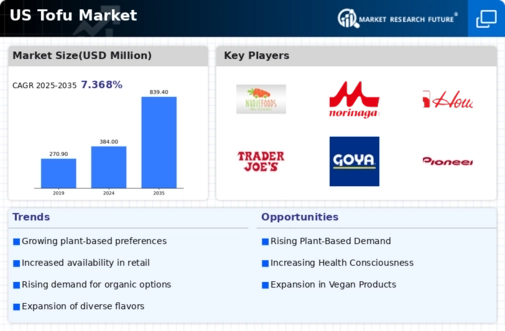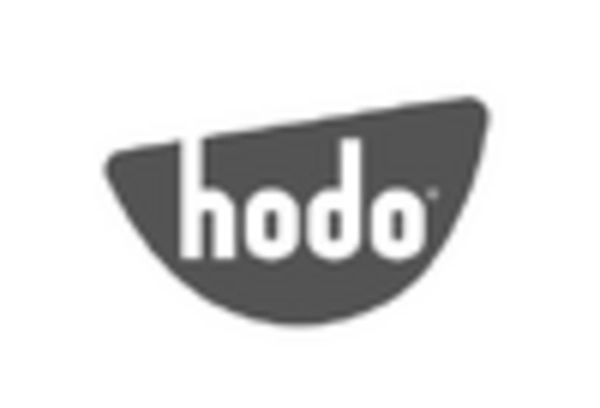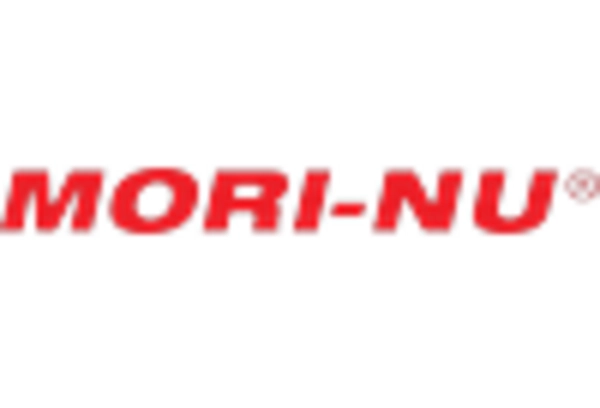Culinary Versatility and Innovation
The culinary versatility of tofu is a notable driver for the tofu market, as it can be incorporated into a wide array of dishes across various cuisines. This adaptability allows tofu to appeal to diverse consumer preferences, from stir-fries to smoothies. Additionally, innovation in product offerings, such as flavored or pre-marinated tofu, enhances its appeal and convenience for consumers. Recent market data suggests that the introduction of new tofu products has contributed to a 15% increase in sales within the tofu market over the past year. As chefs and home cooks alike experiment with tofu in creative ways, the market is likely to expand further. This trend indicates that the tofu market may continue to thrive as culinary exploration encourages consumers to embrace tofu as a staple ingredient.
Health Consciousness Among Consumers
The growing awareness of health and wellness among consumers appears to be a pivotal driver for the tofu market. As individuals increasingly seek nutritious alternatives to animal-based proteins, tofu, known for its high protein content and low saturated fat, becomes an attractive option. Recent data indicates that approximately 30% of consumers in the US are actively reducing their meat consumption, which correlates with a rise in plant-based diets. This trend suggests that the tofu market is likely to experience sustained growth as more individuals prioritize healthful eating habits. Furthermore, the increasing prevalence of lifestyle-related diseases has prompted consumers to explore healthier food choices, further bolstering the demand for tofu products. Consequently, the tofu market is positioned to benefit from this heightened focus on health and nutrition.
Rising Vegan and Vegetarian Populations
The increasing number of individuals identifying as vegan or vegetarian is a crucial driver for the tofu market. Recent statistics reveal that approximately 5% of the US population identifies as vegan, while around 3% consider themselves vegetarian. This demographic shift suggests a growing acceptance of plant-based diets, which inherently boosts the demand for tofu as a primary protein source. As more consumers adopt these lifestyles, the tofu market is likely to benefit from heightened interest in plant-based foods. Furthermore, the rise of social media and online communities dedicated to veganism and vegetarianism has facilitated the sharing of recipes and cooking tips, further promoting tofu consumption. This trend indicates that the tofu market may continue to expand as the vegan and vegetarian populations grow.
Increased Availability in Retail Channels
The expansion of tofu products in various retail channels is a significant driver for the tofu market. As grocery stores and supermarkets increasingly stock a diverse range of tofu options, consumers have greater access to these products. Recent data indicates that tofu sales in retail outlets have risen by approximately 20% over the past year, reflecting a growing consumer interest. This increased availability not only caters to existing tofu enthusiasts but also introduces new consumers to the product. Additionally, the rise of online grocery shopping has further facilitated access to tofu, allowing consumers to explore different brands and varieties from the comfort of their homes. This trend suggests that the tofu market is likely to continue its upward trajectory as retail channels adapt to meet consumer demand.
Sustainability and Environmental Concerns
Sustainability has emerged as a significant concern for consumers, influencing their purchasing decisions in the tofu market. As awareness of environmental issues grows, many individuals are seeking eco-friendly food options. Tofu, being a plant-based protein, generally has a lower carbon footprint compared to meat production. Research indicates that producing 1 kg of tofu emits approximately 2.5 kg of CO2, whereas beef production can emit up to 27 kg of CO2 for the same amount. This stark contrast highlights tofu's potential as a sustainable protein source. As consumers increasingly align their values with their food choices, the tofu market is likely to see a surge in demand from environmentally conscious individuals. This shift towards sustainability may also encourage manufacturers to adopt more eco-friendly practices, further enhancing the appeal of tofu products.

















Leave a Comment